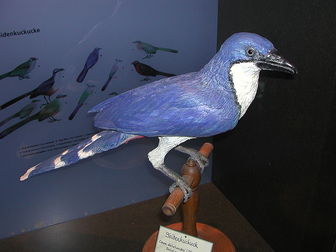Snail-eating Coua
Delalande's Coua , also known as Snail-eating Coua and Delalande's Coucal, is an extinct species of non-parasitic cuckoo. It only was known to science as an extant bird for a very short time in the early 19th century. There is some disagreement about its area of occurrence: Although there were claims that the bird was also found in the area of Fito and Maroantsetra as well as near Toamasina - ie.

Original source: : photo uploaded by User:RicciSpeziari. Photographer: Riccardo Speziari
Permission: GNU Free Documentation License
The Snail-eating Coua is classified as Extinct (EX), there is no reasonable doubt that the last individual has died.
All 13 museum specimens of the Snail-eating Coua were collected in a relatively short period of time. Temminck described the species in 1827 on the basis of 'an unique specimen' which he had seen in the Mus More
Snail-eating Coua and Delalande's Coucal, is an extinct species of non-parasitic cuckoo. It only was known to science as an extant bird for a very short time in the early 19th century. There is some disagreement about its area of occurrence: Although there were claims that the bird was also found in the area of Fito and Maroantsetra as well as near Toamasina (Tamatave) - i.e. More
Snail-eating Coua (Coua delalandei), a member of the cuckoo family, became extinct. The last specimen of this large, slate-blue bird was taken on an islet off the east coast, Ile Sainte-Marie, in 1834 (Morris and Hawkins 1998); reports by observers who claimed to have seen the bird were recorded as late as 1930 (Fuller 1987). The causes of this bird's disappearance, and even its exact range, remain obscure (Langrand 1990). More
Snail-eating Coua, Coua delalandei, of Madagascar had been seen alive (or recorded as such) for the last time some 10 years before, and the Wattled Crane, Bugeranus carunculatus, similarly bound to the interior marshes of Africa (albeit over a wider area), had been recognised for over 60 years. More

Original source: Emijrpbot
Author: Emijrpbot
Permission: Some rights reserved
Family : Cuculidae
Genus : Coua
Species : delalandei
Authority : (Temminck, 1827)

